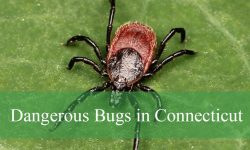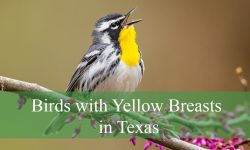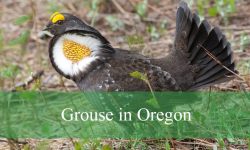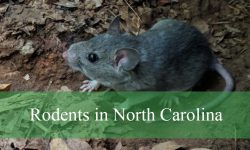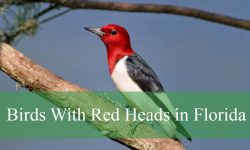If you have ever walked along Florida’s beaches or explored its wetlands, you have probably noticed tall white birds standing gracefully in the water or flying silently above the marshes. These striking birds capture attention with their bright plumage and long bills, which they use skillfully to hunt and feed.
Florida’s mild climate and rich variety of habitats provide perfect conditions for many species of wading and coastal birds. From the shallow freshwater marshes of the Everglades to the mangrove shores and tidal flats of the Gulf Coast, these birds thrive across the state in both wild and urban areas.
This guide highlights ten of the most common white birds with long beaks found in Florida. Each species can be identified by its size, bill shape, feeding behavior, and preferred habitat, helping birdwatchers and nature enthusiasts better understand and appreciate these graceful residents of the Sunshine State.
Types of White Birds with Long Beaks Found in Florida
Great Egret (Ardea alba)
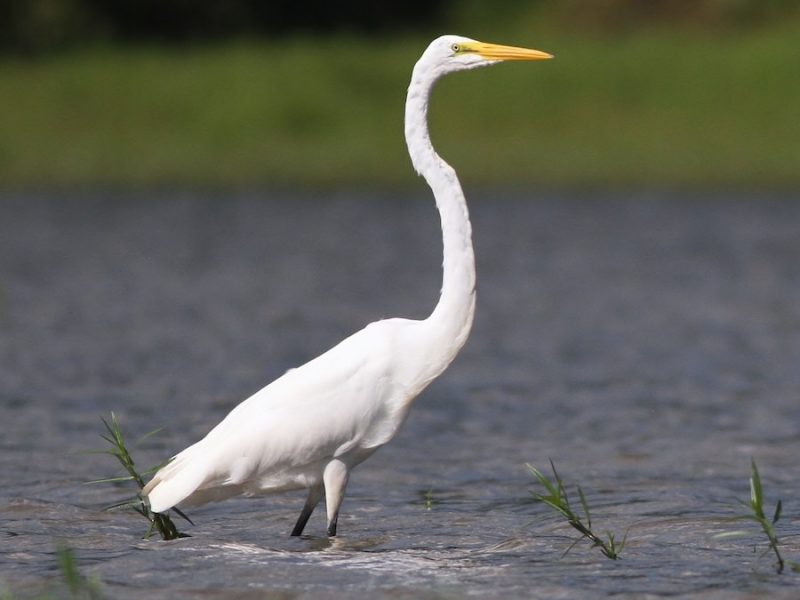
The Great Egret is one of Florida’s most iconic wading birds, recognized for its tall, slender frame and graceful posture. Adults typically stand around 39 inches (1 meter) tall with a wingspan reaching up to 55 inches. Its pure white plumage contrasts beautifully with its long black legs and yellow-orange dagger-like bill, which becomes greener during the breeding season. The bird’s long S-shaped neck is often folded back in flight, making its silhouette easy to identify against Florida’s wetland backdrops.
Behaviorally, Great Egrets are patient hunters. They move slowly through shallow water or stand motionless, waiting for prey to come within striking distance. With lightning-fast precision, they spear small fish, amphibians, and crustaceans using their sharp bill. During courtship, males display spectacular ornamental plumes on their backs, fanning them to attract females while performing slow, deliberate neck movements.
In Florida, Great Egrets inhabit freshwater and saltwater wetlands, marshes, mangroves, lakes, and ponds. They are common residents across the state year-round, especially in the Everglades, St. Johns River basin, and coastal estuaries. Their adaptability to both wild and suburban wetlands makes them one of the most easily observed large wading birds in Florida.
Snowy Egret (Egretta thula)
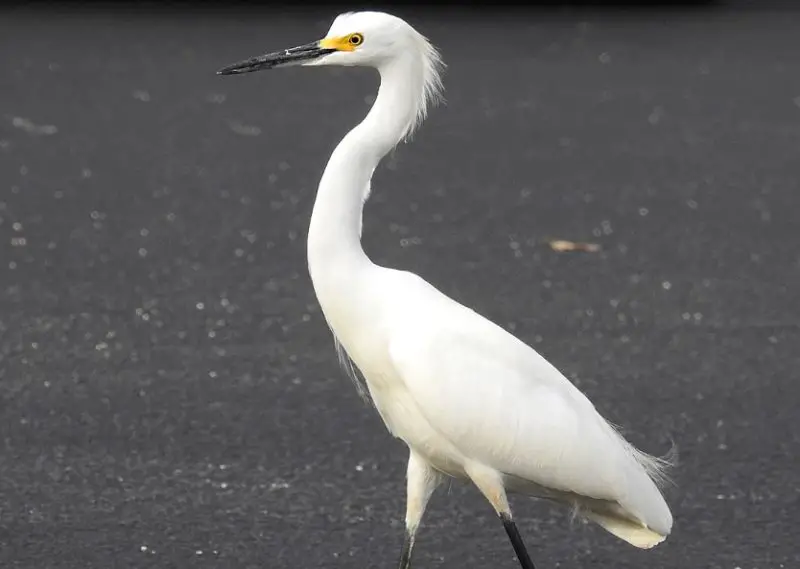
The Snowy Egret is smaller and more active than its cousin, the Great Egret. Standing about 24 inches tall with a wingspan near 39 inches, this elegant bird displays striking features—snowy white plumage, slender black legs, and vibrant yellow feet, often described as “golden slippers.” Its black bill is thin and slightly down-curved, and during the breeding season, its lores (the area between the eyes and bill) turn a vivid red, adding to its charm.
Snowy Egrets are animated feeders, frequently seen darting, hopping, and even running through shallow waters to chase prey. They often stir up fish and invertebrates with their bright feet, creating ripples that flush prey toward the surface. Their energetic and somewhat erratic feeding behavior makes them easy to distinguish from the more methodical Great Egret.
In Florida, Snowy Egrets thrive in estuaries, mangrove swamps, coastal lagoons, and freshwater marshes. They are widespread throughout the state, with strong populations along both the Atlantic and Gulf coasts. Once hunted heavily for their decorative feathers, Snowy Egret populations have rebounded thanks to strict conservation protections.
Wood Stork (Mycteria americana)
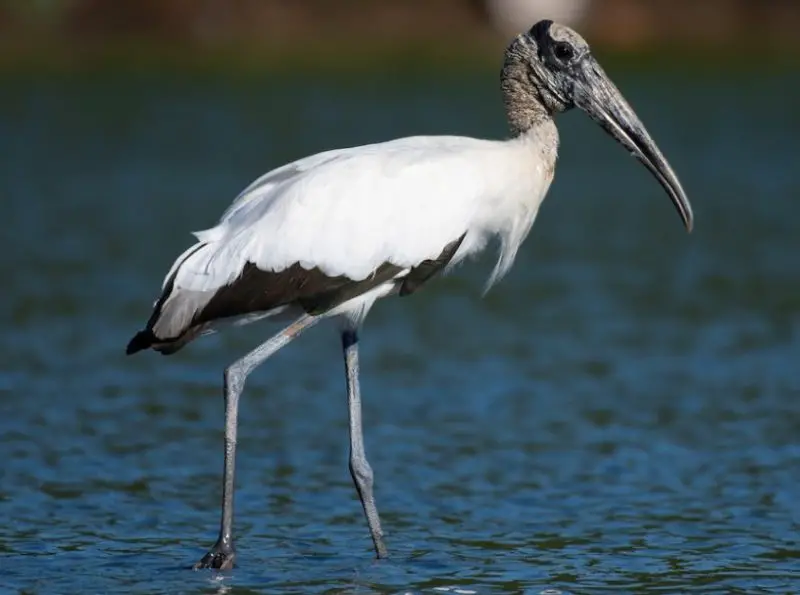
The Wood Stork is an unmistakable sight among Florida’s wading birds. It’s a large, long-legged bird reaching up to 45 inches in height with a wingspan that can exceed 65 inches. Its body is entirely white except for the black flight feathers on its wings, and it has a dark, bald head covered in rough, scaly skin. The bill is thick, long, and slightly curved, perfect for tactile feeding.
Unlike visual hunters like herons and egrets, Wood Storks rely on touch to find food. They wade slowly through shallow water with their bills partially open, snapping them shut instantly when they sense a fish or amphibian. They often feed in groups, especially during the dry season when water levels drop and prey becomes concentrated. In flight, Wood Storks soar gracefully on thermal currents with outstretched necks and downturned bills.
In Florida, Wood Storks breed in large colonies, primarily in South and Central Florida wetlands such as the Everglades, Corkscrew Swamp, and Big Cypress National Preserve. They prefer cypress swamps, freshwater marshes, and mangrove forests. Though listed as a threatened species, their populations have stabilized due to ongoing wetland restoration efforts in Florida.
White Ibis (Eudocimus albus)
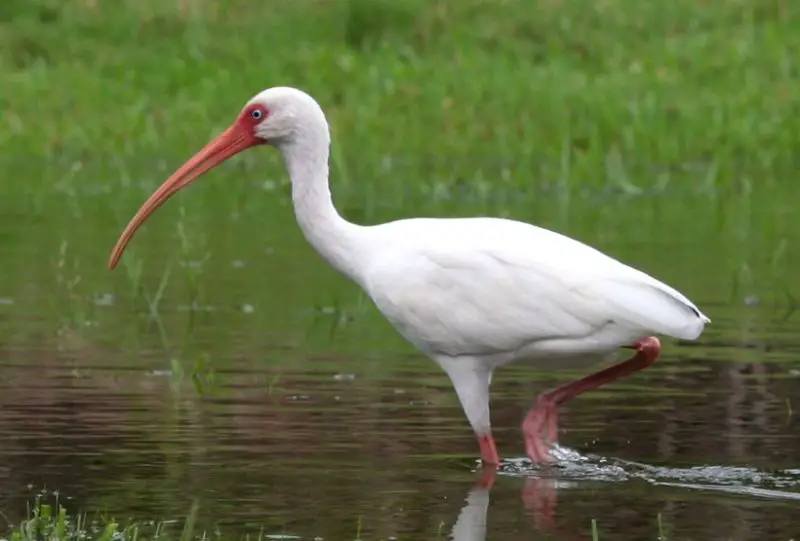
The White Ibis is a medium-sized wading bird easily recognized by its long, downward-curving reddish-orange bill, pinkish legs, and pure white body accented with black wing tips visible during flight. Adults measure around 24 inches in height, with a wingspan up to 41 inches. Juveniles are brownish-gray, gradually turning white as they mature, making mixed-age flocks a common sight.
White Ibises feed primarily by probing their long bills into soft mud or shallow water to find crustaceans, small fish, and insects. They often forage in flocks, moving together across wetlands or even suburban lawns. Their gentle, social nature and adaptability have made them one of the most frequently encountered wading birds across Florida. During breeding season, they form large colonies, building nests in mangroves, cypress trees, or islands surrounded by water.
This species is abundant throughout the state and can be found in nearly every habitat with shallow water—coastal marshes, estuaries, freshwater ponds, and city parks. The White Ibis is a year-round resident and holds cultural significance in Florida, famously serving as the mascot for the University of Miami. Their presence is often seen as an indicator of healthy wetland ecosystems.
American White Pelican (Pelecanus erythrorhynchos)
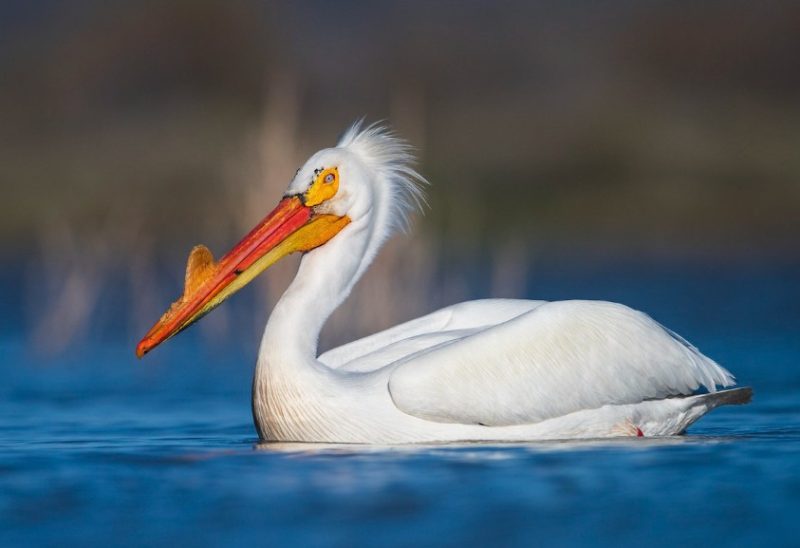
The American White Pelican is among the largest birds in North America, measuring up to 70 inches long with an extraordinary wingspan that can reach 9 feet. It is entirely white except for its black primary feathers visible during flight. Its most defining feature is its enormous orange bill with a flexible throat pouch capable of holding several gallons of water. During the breeding season, adults develop a yellowish crest and a distinctive horn on the upper bill, which later falls off.
These pelicans feed cooperatively, often forming semicircles in shallow water to herd fish toward one another. Unlike Brown Pelicans, which dive for food, White Pelicans scoop fish while swimming, using teamwork and coordination. They are graceful flyers, often seen gliding high in the sky with slow, powerful wingbeats.
In Florida, American White Pelicans are primarily winter visitors, arriving in large numbers from breeding grounds in the northern U.S. and Canada. They frequent inland lakes, lagoons, and coastal refuges such as Merritt Island National Wildlife Refuge, Ding Darling National Wildlife Refuge, and St. Marks National Wildlife Refuge. These massive birds prefer calm, shallow waters rich in fish, making Florida’s coastal wetlands an ideal wintering ground.
Royal Tern (Thalasseus maximus)
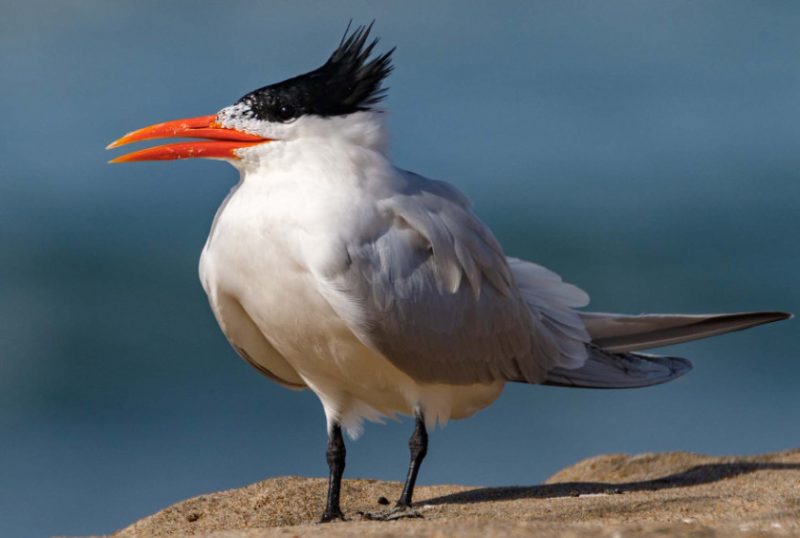
The Royal Tern is a medium-to-large seabird measuring about 18 to 21 inches in length with an impressive wingspan of up to 52 inches. It has a sleek white body, pale gray wings, and a bright orange bill that is long, slightly curved, and pointed. During the breeding season, it displays a black cap and shaggy crest that give it a striking, crowned appearance, while in winter, the black coloration recedes to the back of the head, leaving a white forehead.
Royal Terns are powerful and agile fliers, often seen gliding gracefully over coastal waters before plunging into the sea to catch fish. They feed mainly on small schooling fish such as anchovies, menhaden, and mullet, diving from heights of 10 to 30 feet with precision. Their loud, rolling “keer” calls are a signature sound along Florida’s beaches and coastal islands, especially during the nesting season.
In Florida, Royal Terns are year-round residents along both the Atlantic and Gulf coasts. They breed in large colonies on sandy barrier islands, sandbars, and offshore spits, sharing space with gulls and other terns. Common nesting areas include Cape Romano, Egmont Key, and the Florida Keys. They are especially abundant from spring through early autumn when fish populations peak.
Great White Heron (Ardea herodias occidentalis)
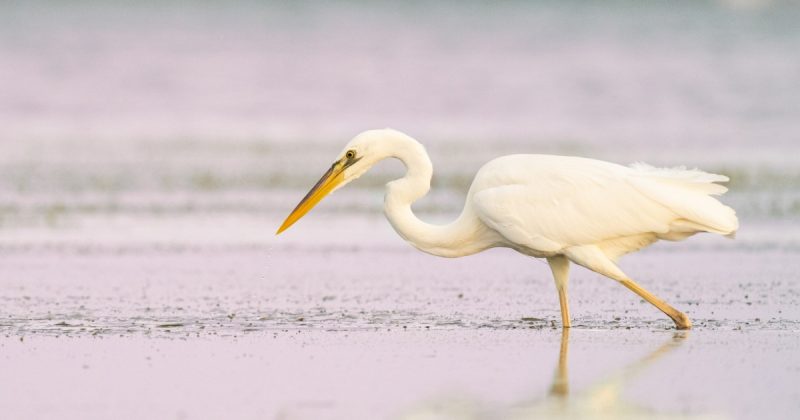
The Great White Heron is a magnificent and rare wading bird, considered a white color morph of the Great Blue Heron. It is one of the largest herons in North America, standing up to 54 inches tall with a wingspan exceeding 80 inches. Unlike the Great Egret, which it resembles, this bird has a heavier, dagger-like yellow bill and pale yellowish legs. Its pure white plumage and substantial size make it an unmistakable presence in the shallow coastal waters of southern Florida.
Behaviorally, Great White Herons are solitary hunters. They stand motionless in shallow waters or slowly stalk fish, crustaceans, and other aquatic prey. Their powerful bill is used to spear prey with accuracy. They are less social than other herons and tend to maintain large territories, particularly during breeding season, which occurs from late winter through early summer.
This heron’s range is extremely limited—it is found almost exclusively in the Florida Keys, Florida Bay, and occasionally in the Everglades. It prefers saltwater habitats such as mangrove-lined coastlines, tidal flats, and shallow lagoons. Because of its restricted range and low population, the Great White Heron is considered a prized species for birdwatchers and an important symbol of Florida’s unique coastal ecosystem.
Reddish Egret (White Morph) (Egretta rufescens)
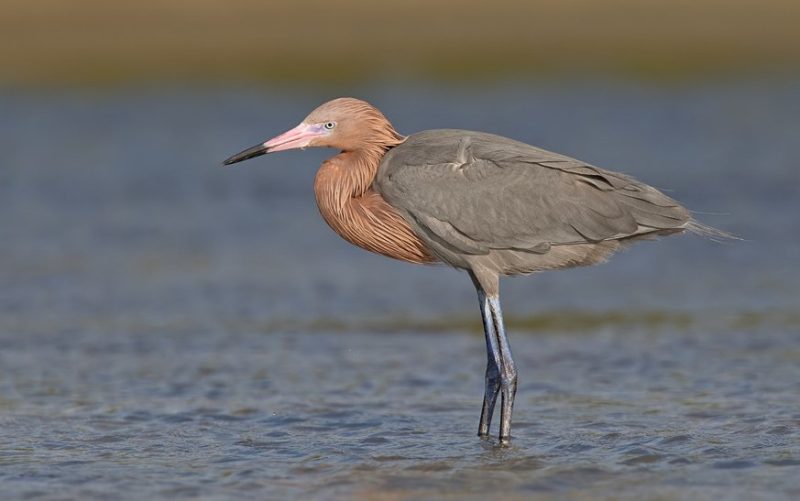
The Reddish Egret is a medium-sized heron reaching about 27 to 32 inches in height with a wingspan of approximately 46 inches. The white morph of this species is particularly eye-catching, with entirely white plumage, a pinkish base on its bluish-gray bill tipped in black, and long slate-gray legs. Its slender build and energetic movements set it apart from more composed egrets like the Snowy or Great Egret.
This bird is famous for its dynamic feeding behavior—often described as a “dance.” It runs, spins, leaps, and fans its wings while chasing fish through shallow tidal flats. This dramatic foraging style helps it startle and corral small prey, allowing for quick strikes. Despite its elegance, it is one of the most animated wading birds you’ll see in Florida.
In Florida, the white morph of the Reddish Egret is found mainly along the Gulf Coast, the Florida Keys, and shallow coastal lagoons. It prefers saltwater or brackish environments such as mudflats, tidal creeks, and mangrove shallows. Though rare, sightings are most frequent in wildlife refuges such as Merritt Island and J.N. “Ding” Darling National Wildlife Refuge. Because of habitat loss, this species is listed as threatened in Florida, making every encounter remarkable for birdwatchers and photographers.
Caspian Tern (Hydroprogne caspia)
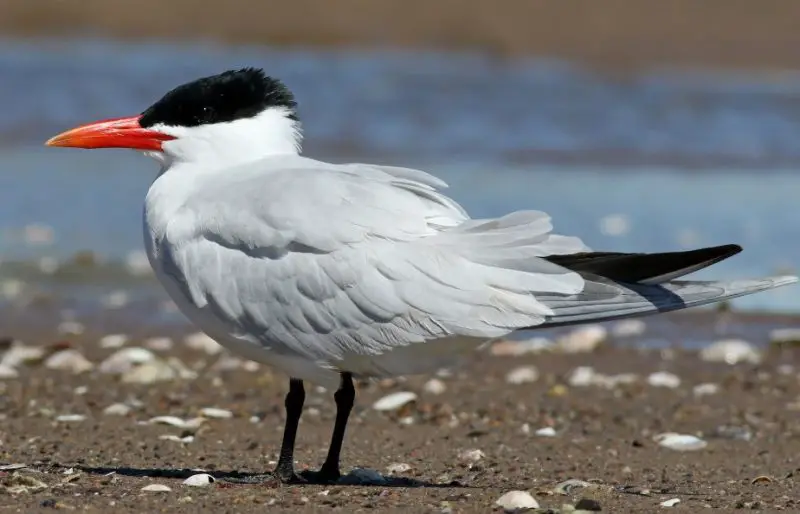
The Caspian Tern is the largest tern species in the world, measuring about 21 inches in length with a wingspan of up to 57 inches. It has a robust build, white body, pale gray wings, and a distinctive thick red-orange bill with a slightly dusky tip. In breeding plumage, the tern’s head bears a glossy black cap, which recedes to a black streak on the crown in winter. Its long, pointed wings and deeply forked tail make it a graceful yet powerful flier.
Caspian Terns are expert fishers, often seen soaring over coastal waters before plunging headfirst into the surface to catch fish. They emit a loud, guttural “kraah” call that can be heard long before the bird is visible, distinguishing them from smaller tern species. Their diet consists mostly of small fish, though they occasionally eat insects and crustaceans.
In Florida, Caspian Terns are commonly seen along the coast during migration and winter months, though some remain year-round in suitable habitats. They nest on sandy islands, coastal dunes, and deltas with sparse vegetation, often sharing colonies with gulls and other terns. Key sites include the Tampa Bay region, Merritt Island, and Apalachicola Bay. Their presence in Florida’s coastal ecosystem reflects the state’s role as an important wintering and breeding area for seabirds.
Roseate Spoonbill (Juvenile) (Platalea ajaja)
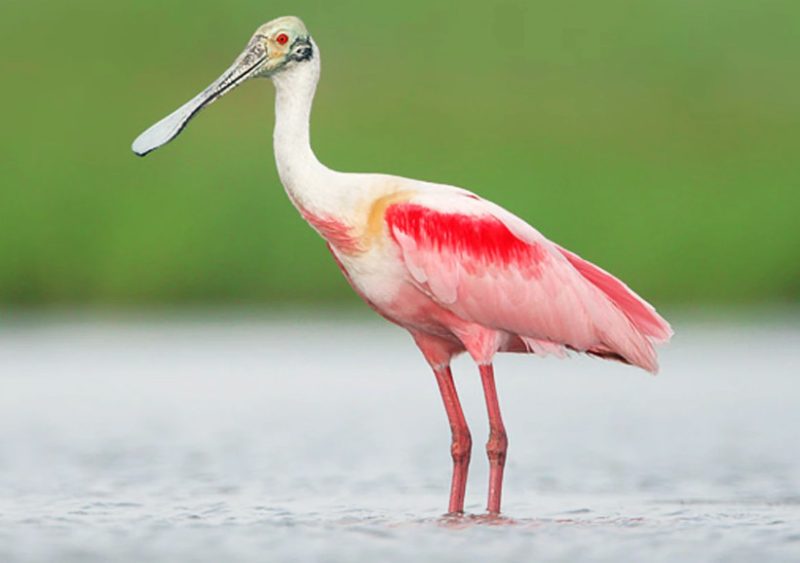
Juvenile Roseate Spoonbills are among Florida’s most fascinating young waders. At this stage, they are mostly white with faint pink washes on their wings and body. Their long, flat, spoon-shaped bills are gray and not yet as vividly colored as in adults. They stand about 28 to 34 inches tall with a wingspan of nearly 50 inches, and as they mature, their feathers deepen to the striking pink hue that gives the species its name.
Juvenile spoonbills feed by sweeping their bills side to side in shallow water, using touch rather than sight to detect small fish, shrimp, and aquatic insects. They often feed in groups, moving slowly through estuaries and mangroves. Over time, their plumage becomes more vibrant, a result of the carotenoid pigments from their diet. Their social nature and unique feeding style make them easy to recognize even among large mixed flocks of wading birds.
In Florida, juvenile Roseate Spoonbills are found mainly in the southern regions, including Florida Bay, the Everglades, Merritt Island, and Tampa Bay estuaries. They prefer mangrove-fringed lagoons, tidal flats, and shallow freshwater wetlands. As adults, they become one of the state’s most iconic and colorful waders, but spotting a young, mostly white spoonbill offers a glimpse into the early stages of one of Florida’s most vibrant native birds.
Tips for Identifying White Birds with Long Beaks in Florida
Focus on Bill Shape and Color
The bill is the most important feature for identifying white birds in Florida. The Great Egret has a long, straight yellow bill, while the Snowy Egret shows a thin, black, slightly curved one. The White Ibis has a distinctive downward-curved red-orange bill, ideal for probing mud. The Wood Stork’s bill is thick, grayish, and curved at the tip. Seabirds such as the Royal Tern and Caspian Tern have long, pointed orange or red bills for catching fish. The Roseate Spoonbill is unmistakable with its wide, flat spoon-shaped bill used for sifting food.
Observe Leg Color and Length
Leg color and proportion also help in identification. Great Egrets have long black legs, Snowy Egrets have black legs with bright yellow feet, and White Ibises have reddish-pink legs. Wood Storks have grayish legs, while terns and pelicans have shorter legs compared to their bodies. Wading birds typically move slowly through shallow water, while seabirds rest or walk briefly on beaches.
Note Size and Posture
Among white birds in Florida, size varies greatly. American White Pelicans are enormous with a wingspan of up to nine feet, while Snowy Egrets are small and delicate. The Wood Stork and Great Egret are tall and upright, but the stork’s heavier build and bare head make it easy to tell apart. Posture also differs—herons and egrets fold their necks into an S-shape during flight, while pelicans and terns fly with their necks extended.
Pay Attention to Behavior
Behavior reveals much about species identity. The Reddish Egret (white morph) runs and spins energetically while hunting. The Great Egret moves slowly and deliberately. The Royal and Caspian Terns dive from height into the ocean to catch fish. The Wood Stork feeds by touch, sweeping its open bill through the water, while the White Ibis probes mud in rhythmic motions.
Consider Habitat and Location
Habitat is one of the best clues. Herons, egrets, ibises, and storks prefer freshwater and brackish wetlands, while terns and pelicans thrive in coastal zones. The Great White Heron is found almost exclusively in the Florida Keys, whereas the American White Pelican prefers inland lakes and estuaries in winter. Observing surroundings often helps narrow possibilities quickly.
Watch for Seasonal Changes
Some species live in Florida year-round, while others appear seasonally. Great Egrets, Snowy Egrets, White Ibises, and Wood Storks stay throughout the year. American White Pelicans and Caspian Terns are winter visitors. During breeding season, birds like Snowy Egrets display colorful lores and elegant plumes, offering clear seasonal identification cues.
FAQs About White Birds with Long Beaks in Florida
What is the large white bird seen standing in Florida’s wetlands?
That is usually the Great Egret. It is tall, with pure white feathers, a yellow bill, and black legs. It stands still for long periods while hunting fish or frogs in shallow water.
Which white bird in Florida has red legs and a curved red bill?
The White Ibis has pinkish-red legs and a long downward-curved red-orange bill. It feeds by probing into wet soil or mud to catch crustaceans and insects, often seen in flocks across grassy areas and wetlands.
What is the difference between a Great Egret and a Snowy Egret?
The Great Egret is larger with a yellow bill and black legs. The Snowy Egret is smaller with a black bill, black legs, and bright yellow feet. The Snowy Egret also moves faster when feeding, often stirring water with its feet.
Where can Great White Herons be found in Florida?
The Great White Heron is found almost entirely in the Florida Keys and southern coastal areas such as Florida Bay and the lower Everglades. It prefers mangrove shorelines, tidal flats, and shallow lagoons.
Which white bird dives into the ocean to catch fish?
Both the Royal Tern and Caspian Tern dive from the air into the sea to catch fish. The Caspian Tern is larger and has a deep, hoarse call, while the Royal Tern is slightly smaller with a graceful flight and loud rolling calls.
Are American White Pelicans in Florida year-round?
American White Pelicans spend winters in Florida, arriving in late fall and leaving by early spring. They gather in large numbers at Merritt Island, Ding Darling, and St. Marks National Wildlife Refuges.
What white bird has a spoon-shaped bill?
The Roseate Spoonbill has a wide, flat bill shaped like a spoon. Juveniles are mostly white with faint pink shades that deepen as they mature. They use their bills to sift food from shallow water in mangroves and estuaries.
Are Wood Storks endangered in Florida?
Wood Storks were once endangered but are now listed as threatened. Their populations have improved due to successful wetland restoration in South and Central Florida, especially in the Everglades and Corkscrew Swamp.
Which white bird performs a dance-like hunting behavior?
The Reddish Egret (white morph) is known for its energetic feeding display, running, spinning, and flapping its wings while chasing fish. It is often found in coastal flats and mangrove shallows.
Do any white birds nest in large colonies?
Yes, species such as the Royal Tern, White Ibis, and Wood Stork form large nesting colonies. These colonies are often located on isolated islands, mangrove forests, or sandbars, providing safe nesting sites for hundreds of birds.

